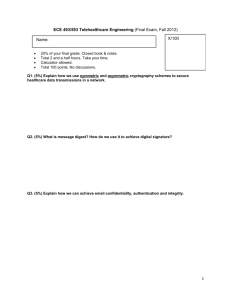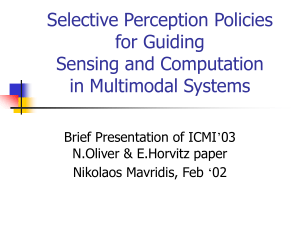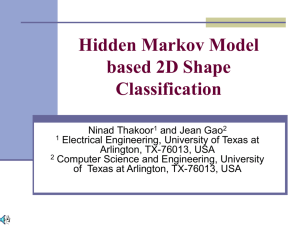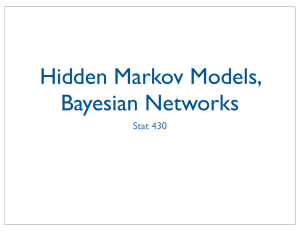Hidden • – Lecture # 10
advertisement
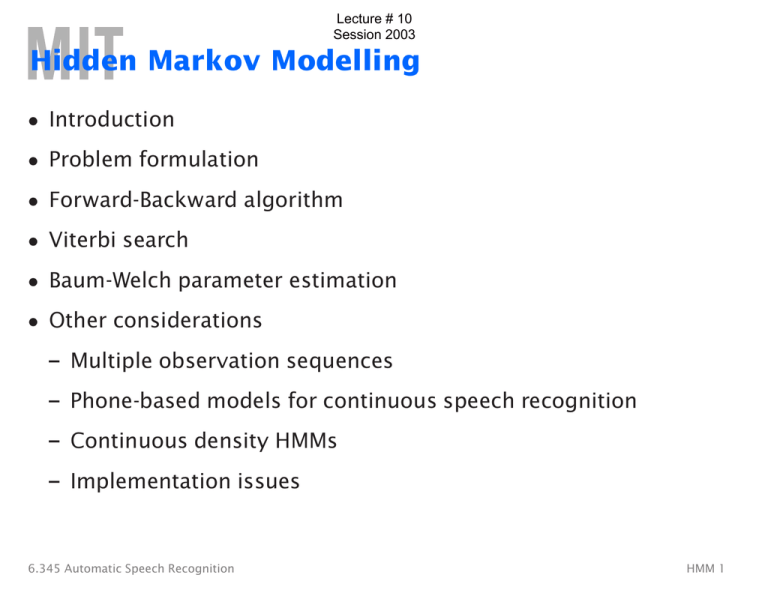
Lecture # 10
Session 2003
Hidden Markov Modelling
• Introduction
• Problem formulation
• Forward-Backward algorithm
• Viterbi search
• Baum-Welch parameter estimation
• Other considerations
– Multiple observation sequences
– Phone-based models for continuous speech recognition
– Continuous density HMMs
– Implementation issues
6.345 Automatic Speech Recognition
HMM 1
Information Theoretic Approach to ASR
Speech Generation
Text
Generation
Speech
����������
Speech Recognition
Acoustic A Linguistic W
Processor
Decoder
noisy
communication
channel
Recognition is achieved by maximizing the probability of the
linguistic string, W , given the acoustic evidence, A, i.e., choose the
ˆ such that
linguistic sequence W
P(Ŵ |A) = max P(W |A)
W
6.345 Automatic Speech Recognition
HMM 2
Information Theoretic Approach to ASR
• From Bayes rule:
P(W |A) =
P(A|W )P(W )
P(A)
• Hidden Markov modelling (HMM) deals with the quantity P(A|W )
• Change in notation:
A
W
P(A|W )
6.345 Automatic Speech Recognition
→
→
→
O
λ
P(O|λ)
HMM 3
HMM: An Example
1
2
1
2
1
1
2
2
2
2
1
1
2
0
1
1
2
1
1
1
2
2
2
2
2
2
2
1
1
2
1
1
1
1
2
2
2
2
1
2
• Consider 3 mugs, each with mixtures of state stones, 1 and 2
• The fractions for the i th mug are ai1 and ai2 , and ai1 + ai2 = 1
• Consider 2 urns, each with mixtures of black and white balls
• The fractions for the i th urn are bi (B) and bi (W ); bi (B) + bi (W ) = 1
• The parameter vector for this model is:
λ = {a01 , a02 , a11 , a12 , a21 , a22 , b1 (B), b1 (W ), b2 (B), b2 (W )}
6.345 Automatic Speech Recognition
HMM 4
HMM: An Example (cont’d)
1
1
2
2
1
1
1
2
2
2
1
1
1
2
2
1
2
2
2
2
2
1
1
2
1
2
2
1
1
2
2
2
2
2
1
2
2
1
1
2
2
1
2
2
1
2
1
1
1
1
1
1
1
2
2
2
2
2
1
1
1
2
2
2
2
0
1
1
2
1
2
1
1
2
1
2
1
1
1
2
1
2
1
Observation Sequence:
State Sequence:
1
O = {B, W , B, W , W , B}
Q = {1, 1, 2, 1, 2, 1}
Goal: Given the model λ and the observation sequence O,
how can the underlying state sequence Q be determined?
6.345 Automatic Speech Recognition
HMM 5
Elements of a Discrete Hidden Markov Model
• N : number of states in the model
– states, s = {s1 , s2 , . . . , sN }
– state at time t, qt ∈ s
• M: number of observation symbols (i.e., discrete observations)
– observation symbols, v = {v1 , v2 , . . . , vM }
– observation at time t, ot ∈ v
• A = {aij }: state transition probability distribution
– aij = P(qt+1 = sj |qt = si ), 1 ≤ i, j ≤ N
• B = {bj (k)}: observation symbol probability distribution in state j
– bj (k) = P(vk at t|qt = sj ), 1 ≤ j ≤ N, 1 ≤ k ≤ M
• π = {πi }: initial state distribution
– πi = P(q1 = si ), 1 ≤ i ≤ N
Notationally, an HMM is typically written as: λ = {A, B, π}
6.345 Automatic Speech Recognition
HMM 6
HMM: An Example (cont’d)
For our simple example:
�
π = {a01 , a02 },
A=
a11 a12
a21 a22
�
�
, and
B=
b1 (B) b1 (W )
b2 (B) b2 (W )
�
State Diagram
2-state
a11
3-state
a22
a12
1
2
1
2
3
a21
{b1(B), b1(W)} {b 2(B), b 2(W)}
6.345 Automatic Speech Recognition
HMM 7
Generation of HMM Observations
1. Choose an initial state, q1 = si , based on the initial state
distribution, π
2. For t = 1 to T :
• Choose ot = vk according to the symbol probability distribution
in state si , bi (k)
• Transition to a new state qt+1 = sj according to the state
transition probability distribution for state si , aij
3. Increment t by 1, return to step 2 if t ≤ T ; else, terminate
a 0i
a ij
q1
q2
.....
qT
bi (k)
o1
6.345 Automatic Speech Recognition
o2
oT
HMM 8
Representing State Diagram by Trellis
2
1
3
s1
s2
s3
0
1
2
3
4
The dashed line represents a null transition, where no observation
symbol is generated
6.345 Automatic Speech Recognition
HMM 9
Three Basic HMM Problems
1. Scoring: Given an observation sequence O�= {o1 , o2 , ..., oT } and a
model λ = {A, B, π}, how do we compute P(O�| λ), the probability
of the observation sequence?
==> The Forward-Backward Algorithm
2. Matching: Given an observation sequence O�= {o1 , o2 , ..., oT }, how
do we choose a state sequence Q�= {q1 , q2 , ..., qT } which is
optimum in some sense?
==> The Viterbi Algorithm
3. Training: How do we adjust the model parameters λ = {A, B, π} to
maximize P(O�| λ)?
==> The Baum-Welch Re-estimation Procedures
6.345 Automatic Speech Recognition
HMM 10
Computation of P(O|λ)
P(O|λ) =
�
P(O, Q�|λ)
allQ�
P(O, Q�|λ) = P(O|Q�, λ)P(Q�|λ)
• Consider the fixed�state sequence: Q�= q1 q2 . . . qT
P(O|Q�, λ) = bq1 (o1 )bq2 (o2 ) . . . bqT (oT )
P(Q�|λ) = πq1 aq1 q2 aq2 q3 . . . aqT −1 qT
Therefore:
P(O|λ) = �
q1 ,q2 ,...,qT
πq1 bq1 (o1 )aq1 q2 bq2 (o2 ) . . . aqT −1 qT bqT (oT )
• Calculation required ≈ 2T · N T (there are N T such sequences)
For N = 5, T = 100 ⇒ 2 · 100 · 5100 ≈ 1072 computations!
6.345 Automatic Speech Recognition
HMM 11
The Forward Algorithm
• Let us define the forward variable, αt (i), as the probability of the
partial observation sequence up to time t and�state si at time t,
given the model, i.e.
αt (i) = P(o1 o2 . . . ot , qt = si |λ)
• It can easily be shown that:
α1 (i) = πi bi (o1 ),
P(O|λ) =
αT (i)
i=1
• By induction:
αt+1 (j ) = [
N
�
1≤i≤N
N
�
i=1
αt (i ) aij ]bj (ot+1 ),
1≤t ≤T −1
1≤j≤N
• Calculation is on the order of N 2 T .
For N = 5, T = 100 ⇒ 100 · 52 computations, instead of 1072
6.345 Automatic Speech Recognition
HMM 12
Forward Algorithm Illustration
s1
a1j
αt(i)
si
aij
αt+1(j)
sj
ajj
aNj
sN
1
6.345 Automatic Speech Recognition
t
t+1
T
HMM 13
The Backward Algorithm
• Similarly, let us define the backward variable, βt (i), as the
probability of the partial observation sequence from time t + 1 to
the end, given state si at time t and the model, i.e.
βt (i) = P(ot+1 ot+2 . . . oT |qt = si , λ)
• It can easily be shown that:
1≤i≤N
βT (i) = 1,
and:
P(O|λ) =
N
�
πi bi (o1 )β1 (i)
i=1
• By induction:
βt (i ) =
N
�
aij bj (ot+1 ) βt+1 (j ),
j=1
6.345 Automatic Speech Recognition
t = T − 1, T − 2, . . . , 1
1≤i≤N
HMM 14
Backward Procedure Illustration
s1
ai1
βt(i)
si
aii
aij
βt+1(j)
sj
aiN
sN
1
6.345 Automatic Speech Recognition
t
t+1
T
HMM 15
Finding Optimal State Sequences
• One criterion chooses states, qt , which are individually most likely
– This maximizes the expected number of correct states
• Let us define γt (i)�as the probability of being in state si at time t,
given the observation sequence and the model, i.e.
γt (i) = �P (qt =�si |O, λ)
N
�
γt (i) = 1,
∀t
i=1
• Then the individually most likely state, qt , at time t is:
qt =�argmax� γt (i)
1≤i≤N
1�≤ t ≤ T
• Note that it can be shown that:
αt (i)βt (i)�
γt (i) = �
P(O|λ)�
6.345 Automatic Speech Recognition
HMM 16
Finding Optimal State Sequences
• The individual optimality criterion has the problem that the
optimum state sequence may not obey state transition constraints
• Another optimality criterion is to choose the state sequence which
maximizes P(Q , O|λ); This can be found by the Viterbi algorithm
• Let us define δt (i)�as the highest probability along a single path, at
time t, which accounts for the first t observations, i.e.
δt (i) = � max� P(q1 q2�. . . qt−1 , qt =�si , o1 o2�. . . ot |λ)
q1 ,q2 ,...,qt−1�
• By induction:
δt+1 (j) = [max�δt (i)aij ]bj (ot+1 )�
i
• To retrieve the state sequence, we must keep track of the state
sequence which gave the best path, at time t, to state si
– We do this in a separate array ψt (i)�
6.345 Automatic Speech Recognition
HMM 17
The Viterbi Algorithm
1. Initialization:
δ1 (i) = π�i bi (o1 ),
ψ1 (i) = 0�
1�≤ i ≤ N
� [δt−1 (i)aij ]bj (ot ),
δt (j) = max�
2�≤ t ≤ T
2. Recursion:
1≤i≤N
2�≤ t ≤ T
ψt (j)� =�argmax[δt−1 (i)aij ],
1≤i≤N
3. Termination:
1�≤ j ≤ N
1�≤ j ≤ N
P ∗ = max�[δT (i)]�
qT∗
1≤i≤N
=�argmax[δT (i)]
1≤i≤N
4. Path (state-sequence) backtracking:
qt∗ =�ψt+1 (qt∗+1 ),
t =�T − 1, T − 2, . . . , 1�
Computation ≈ N 2 T
6.345 Automatic Speech Recognition
HMM 18
The Viterbi Algorithm: An Example
.8
.2
.5
.5
.7
.3
.5
.5
.3
1
P(a)
P(b)
.3
.7
.4
2
3
.2
.1
O={a a b b}
.40
s1
s2
a
a
0
.40
.21
.21
.20
.20
.20
.20
.10
.15
.10
b
b
.10
.10
.09
.09
.20
.20
.20
.20
.35
.15
.10
.10
.35
.20
.10
s3
0
6.345 Automatic Speech Recognition
1
2
3
4
HMM 19
The Viterbi Algorithm: An Example (cont’d)
a
0
s1
1.0
s2
s1 , 0
.2
s3
s2 , 0
.02
aa
aab
aabb
s1 , a
.4
s1 , a
.16
s1 , b
.016
s1 , b
.0016
s1 , 0
s1 , a
s2 , a
s2 , 0
.08
.21
.04
.021
s1 , 0
s1 , a
s2 , a
s2 , 0
.032
.084
.042
.0084
s1 , 0
s1 , b
s2 , b
s2 , 0
.0032
.0144
.0168
.00168
s1 , 0
s1 , b
s2 , b
s2 , 0
.00032
.00144
.00336
.000336
s2 , a
.03
s2 , a
.0315
s2 , b
.0294
s2 , b
.00588
0
s1
s2
s3
a
b
b
1.0
0.4
0.16
0.016
0.0016
0.2
0.21
0.084
0.0168
0.00336
0.02
0.03
0.0315
0.0294
0.00588
1
2
3
4
0
6.345 Automatic Speech Recognition
a
HMM 20
Matching Using Forward-Backward Algorithm
a
0
s1
1.0
s2
s1 , 0
.2
s3
s2 , 0
.02
aa
aab
aabb
s1 , a
.4
s1 , a
.16
s1 , b
.016
s1 , b
.0016
s1 , 0
s1 , a
s2 , a
s2 , 0
.08
.21
.04
.033
s1 , 0
s1 , a
s2 , a
s2 , 0
.032
.084
.066
.0182
s1 , 0
s1 , b
s2 , b
s2 , 0
.0032
.0144
.0364
.0054
s1 , 0
s1 , b
s2 , b
s2 , 0
.00032
.00144
.0108
.001256
s2 , a
.03
s2 , a
.0495
s2 , b
.0637
s2 , b
.0189
0
a
a
b
b
s1
1.0
0.4
0.16
0.016
0.0016
s2
0.2
0.33
0.182
0.0540
0.01256
0.02
0.063
0.0677
0.0691
0.020156
1
2
3
4
s3
0
6.345 Automatic Speech Recognition
HMM 21
Baum-Welch Re-estimation
• Baum-Welch re-estimation uses EM to determine ML parameters
• Define ξt (i, j) as the probability of being in state si at time t and
state sj at time t + 1, given the model and observation sequence
ξt (i, j) = P(qt = si , qt+1 = sj |O, λ)
• Then:
αt (i)aij bj (ot+1 )βt+1 (j)
ξt (i, j) =
P(O|λ)
N
�
γt (i) =
ξt (i, j)
j=1
• Summing γt (i) and ξt (i, j), we get:
T�
−1
γt (i) = expected number of transitions from si
t=1
T�
−1
ξt (i, j) = expected number of transitions from si to sj
t=1
6.345 Automatic Speech Recognition
HMM 22
Baum-Welch Re-estimation Procedures
s1
αt(i)
si
aij
sj
βt+1(j)
sN
1
t-1
6.345 Automatic Speech Recognition
t
t+1
t+2
T
HMM 23
Baum-Welch Re-estimation Formulas
¯ =�expected number of times in state si at t = 1 �
π
=�γ1 (i)�
¯ij =�
a
expected number of transitions from state si to sj
expected number of transitions from state si
T�
−1�
ξt (i, j)�
=� t=1
T�
−1�
γt (i)�
t=1�
expected number of times in state sj with symbol vk
¯
bj (k) = �
expected number of times in state sj
T
�
γt (j)�
=�
t=1�
ot =vk
T
�
γt (j)�
t=1�
6.345 Automatic Speech Recognition
HMM 24
Baum-Welch Re-estimation Formulas
¯ = (A,
¯ B,
¯ π)�is
• If λ = (A, B, π)�is the initial model, and λ
¯
the
re-estimated model. Then it can be proved that either:
1. The initial model, λ, defines a critical point of the likelihood
¯ =�λ, or
function, in which case λ
¯ is more likely than λ in the sense that P(O|λ̄)�> P(O|λ),
2. Model λ
¯ from which the observation
i.e., we have found a new model λ
sequence is more likely to have been produced.
• Thus we can improve the probability of O being observed from
¯ in place of λ and repeat the
the model if we iteratively use λ
re-estimation until some limiting point is reached. The resulting
model is called the maximum likelihood HMM.
6.345 Automatic Speech Recognition
HMM 25
Multiple Observation Sequences
• Speech recognition typically uses left-to-right HMMs. These HMMs
can not be trained using a single observation sequence, because
only a small number of observations are available to train each
state. To obtain reliable estimates of model parameters, one must
use multiple observation sequences. In this case, the
re-estimation procedure needs to be modified.
• Let us denote the set of K observation sequences as
O =�{O (1) , O (2) , . . . , O (K) }
(k)
(k)
(k)�
where O (k) =�{o1 , o2� , . . . , oTk } is the k-th observation sequence.
• Assume that the observations sequences are mutually
independent, we want to estimate the parameters so as to
maximize
K
K
�
�
P(O | λ) = � P(O (k)� | λ) = � Pk
k=1�
6.345 Automatic Speech Recognition
k=1�
HMM 26
Multiple Observation Sequences (cont’d)
• Since the re-estimation formulas are based on frequency of
occurrence of various events, we can modify them by adding up
the individual frequencies of occurrence for each sequence
K T�
k −1�
�
ξtk (i, j)�
t=1�
¯ij =� k=1�
a
K T�
k −1�
�
γtk (i)�
=
k=1� t=1�
Tk
K �
�
ot =v�
¯
bj (�) = �
Tk
K �
�
γtk (j)�
k=1t=1�
6.345 Automatic Speech Recognition
K
k −1�
�
1�T�
αkt (i)βkt (i)�
P
k=1� k t=1�
Tk
K
�
1� �
αkt (i)βkt (i)�
P
k=1� k t=1�
γtk (j)�
t=1�
k=1� (k)
K
k −1�
�
1�T�
(k)�
αkt (i)aij bj (ot+1 )βkt+1 (j)�
P
k=1� k t=1�
=�
(k)
ot =v�
Tk
K
�
1� �
αkt (i)βkt (i)�
P
k=1� k t=1�
HMM 27
Phone-based HMMs
• Word-based HMMs are appropriate for small vocabulary speech
recognition. For large vocabulary ASR, sub-word-based (e.g.,
phone-based) models are more appropriate.
6.345 Automatic Speech Recognition
HMM 28
Phone-based HMMs (cont’d)
• The phone models can have many states, and words are made up
from a concatenation of phone models.
6.345 Automatic Speech Recognition
HMM 29
Continuous Density Hidden Markov Models
• A continuous density HMM replaces the discrete observation
probabilities, bj (k), by a continuous PDF bj (x)
• A common practice is to represent bj (x) as a mixture of Gaussians:
bj (x) =
M
�
cjk N[x, µjk , Σjk ]
1≤j≤N
k=1
where
cjk is the mixture weight
cjk ≥ 0 (1 ≤ j ≤ N, 1 ≤ k ≤ M , and
M
�
cjk = 1, 1 ≤ j ≤ N ),
k=1
N is the normal density, and
µjk and Σjk are the mean vector and covariance matrix
associated with state j and mixture k.
6.345 Automatic Speech Recognition
HMM 30
Acoustic Modelling Variations
• Semi-continuous HMMs first compute a VQ codebook of size M
– The VQ codebook is then modelled as a family of Gaussian PDFs
– Each codeword is represented by a Gaussian PDF, and may be
used together with others to model the acoustic vectors
– From the CD-HMM viewpoint, this is equivalent to using the
same set of M mixtures to model all the states
– It is therefore often referred to as a Tied Mixture HMM
• All three methods have been used in many speech recognition
tasks, with varying outcomes
• For large-vocabulary, continuous speech recognition with
sufficient amount (i.e., tens of hours) of training data, CD-HMM
systems currently yield the best performance, but with
considerable increase in computation
6.345 Automatic Speech Recognition
HMM 31
Implementation Issues
• Scaling: to prevent underflow
• Segmental K-means Training: to train observation probabilities by
first performing Viterbi alignment
• Initial estimates of λ: to provide robust models
• Pruning: to reduce search computation
6.345 Automatic Speech Recognition
HMM 32
References
• X. Huang, A. Acero, and H. Hon, Spoken Language Processing,
Prentice-Hall, 2001.
• F. Jelinek, Statistical Methods for Speech Recognition. MIT Press,
1997.
• L. Rabiner and B. Juang, Fundamentals of Speech Recognition,
Prentice-Hall, 1993.
6.345 Automatic Speech Recognition
HMM 33


